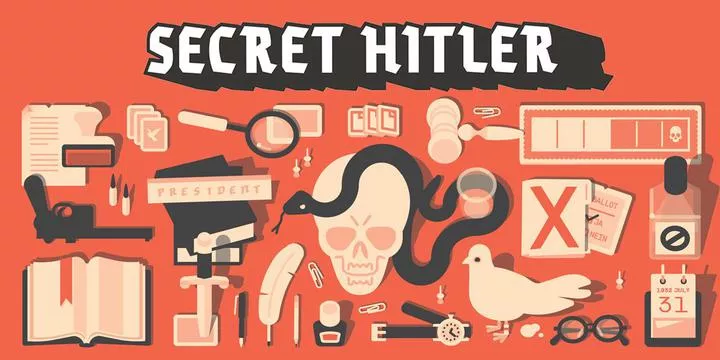Secret Hitler, first released in 2016, was designed by Mike Boxleiter, Tommy Maranges and Max Temkin, with artwork created by Mackenzie Schubert. It was first created as a physical board game, but their creative commons license allows the game to be adapted to other versions including the online link that was provided to us. The target audience is intended for friends and family ages 13+ so all individuals are able to convincingly play different roles and make reason based decisions. With four of my other friends, I played the online version of the game twice!
“How does the game emphasize social deduction through its mechanics? Connect your analysis to the game’s formal elements.”
A social deduction game is a game where players are trying to uncover each other’s hidden roles or team allegiances. Secret Hitler emphasizes social deduction through its game mechanics and formal elements which are interweaved to always intentionally create conflict and distrust, while still presenting opportunities to build trust. This juxtaposition makes Secret Hitler an extremely fun social deduction game.
Starting with players and their objectives, everyone is secretly assigned roles as members of either the liberal or fascist party, with one player becoming Hitler. Liberal players are always in the majority but lack information about anyones’ roles apart from themselves. Fascists are the minority, but they know who each other are, as well as who Hitler is. Hitler’s role is really unique since they know they are on the fascist team, but have no information about who the other fascist players are. As discussed in the readings about formal elements, this game is incredibly interesting because all roles have different objectives and styles of player competition. Liberals objective is either to identify Hitler and eliminate that player from the game or collaborate to pass 5 liberal policies.
In many ways, this starts as unilateral competition since liberal players make individual decisions because they have no knowledge of who is on their side working against the fascist team, but then slowly transitions into a team vs team game as players start to form hypothesis for which players may have the same objectives as them. In the first game we played, I was a liberal and through intense discussions plus what I perceived as “hard evidence” from the policies passed by various chancellor-president pairs, made me form assumptions of who I believed was also a liberal. I began to trust Person A and distrust Person B, using that new found team loyalty to influence my future decisions. However, since it was my first time playing, I was unaware of the exact mechanics regarding policy cards! The mechanics of Secret Hitler are that such there are nearly double the amount of fascist policy cards as there are liberal cards. In the first few rounds, no one wants to seem suspicious so everyone passed liberal policies. This further accentuated the probability of only passing fascist cards in future rounds. Therefore, the game’s formal elements and mechanics worked cohesively to create conflicts each player had to work around, in this case liberals have to decipher between true and false evidence. Hitler’s experience is very similar. They are also trying to determine what evidence and claims are true or false to identify the fascist member on their team. However, the fascist player was the only player who had knowledge of the true teams. This advantage helps offset the previous game mechanic disadvantage of the fascist team being the minority. I thought it was interesting that Hitler’s role was designed so that the player does not know their team members, similar to the liberals. It made the dynamics of the game feel more intense because the fascists were incentivized to fool the liberals into believing they were also liberal while convincing Hitler it was okay to trust them.
Outside of player roles and objectives, there were many other game mechanics and procedures which we started to uncover in our first round and more effectively engaged with in our second round. I realized that many of these were working to create obvious conflicts and distrust amongst players. For example, the mechanics of being able to investigate player cards and eliminate players based on how many fascist policies have been passed. Additionally, every player can vote to approve a chancellor-president pair and we were making those decisions without any strategy beforehand. The opportunity to lie claiming to have received different cards was another game mechanic that was constantly creating conflict. The added conflict was incredibly fun to sort through, and seeing different players reasoning, evidence, and more helped use the same game mechanics to create opportunities for trust formation. In general, I loved this game and can not wait to keep playing with my friends!




